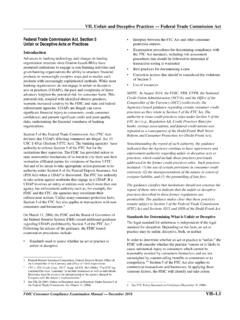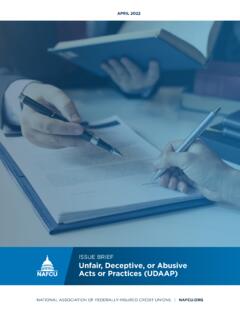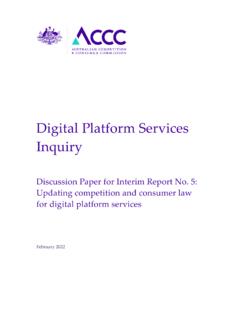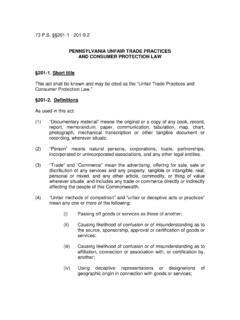Transcription of Fines for breaking EU Competition Law
1 Fines for breaking EU Competition Law What should Fines achieve? The Commission's policy with regards to Competition law infringements is one of prevention. Hence it issues extensive guidance on how to comply with the law. Should companies break the law, Fines may be imposed. These too are ultimately aimed at prevention, and must hence fulfil two objectives: to punish and to deter. breaking the Competition rules is profitable if it goes unpunished that is why companies do it. To take cartels as an example, the OECD looked at a selection of cartels, estimating the median price increase to be 15 to 20%, with a high of over 50%.
2 I If a cartel lasts for several years, then the companies involved benefit from these higher prices for every year of the cartel. The fine has to take this into account if it is to achieve its objective of prevention on industry as a whole. Commission fining policy is based on the principles that some breaches cause more harm to the economy than others, that breaches affecting a high value of sales cause more harm than infringements affecting a low value of sales, and that long-running breaches cause more harm than short ones. How are Fines assessed? Percentage of value of relevant sales: The starting point for the fine is a percentage of the company s annual sales of the product concerned by the infringement.
3 The relevant sales are usually the sales of the products covered by the infringement during the last full year of the The percentage which is applied to the value of the company's relevant sales can be up to 30%, depending on the seriousness of the infringement, which in turn depends on a number of factors, including the nature of the infringement ( the abuse of dominance, price fixing, market sharing), the geographic scope, and whether the infringement has been implemented. For cartels, the relevant percentage tends to be in the range of 15-20%. Duration: This percentage of the value of relevant sales is multiplied by the number of years and months the infringement lasted.
4 This means that the fine is linked to the value of the affected sales during the infringement, which is generally considered to be a good indicator of the damage to the economy caused by the infringement over time. An infringement that lasts for two years is therefore assumed to be twice as damaging as an infringement that lasts for only one. Increases and Decreases: The fine can be increased (for example if the company is a repeat offender), or decreased (for example if the company s involvement was limited, or legislation or authorities encouraged the infringement). In cartel cases the fine will be increased by a one-time amount equivalent to 15-25% of the value of one year's sales as an additional deterrent which bites essentially in the case of short cartels and is designed to deter from even trying out a cartel (so called "entry-fee").
5 Overall limit: The fine is limited to 10% of the overall annual turnover of the company. The 10% limit may be based on the turnover of the group to which the company belongs if the parent of that group exercised decisive influence over the operations of the subsidiary during the infringement period. There is also a limitation period of five years from the end of the infringement until the beginning of the Commission's investigation. Leniency Reductions: The Commission encourages companies that are involved in a cartel to come forward with evidence to help the Commission to detect cartels and build its case.
6 Iii The first company to provide sufficient evidence of a cartel to allow the Commission to pursue the case can receive full immunity from Fines ; subsequent companies can receive reductions of up to 50% on the fine that would otherwise be Settlement Reductions: In cartel cases, the Commission also offers a reduction of 10% in the fine if the Commission reaches a settlement with the Settlements reduce the administrative costs of cartel decisions, including before the court, and help the Commission deal more quickly with cartel cases, freeing up resources to devote to new investigations.
7 Inability to pay In exceptional circumstancesvi, the Commission may reduce the fine if the company provides sufficiently clear and objective evidence that the fine is likely to affect seriously the economic viability of the undertaking. The analysis looks in detail at various company-specific factors, and aims to be as objective and quantifiable as possible to ensure equal treatment and maintain deterrence. What is the legal basis for the Commission s Fines ? Articles 101 and 102 of the Treaty (TFEU) prohibit various anticompetitive practices. Article 103 gives the European Council powers to put in place an enforcement system, including the imposition of Fines .
8 Council Regulation 1/2003,vii based on Article 103 TFEU, gives the Commission powers to enforce these rules and fine companies for infringements. It sets out the principles that the fine should be based on the gravity and the duration of the infringement and caps the maximum fine at 10% of turnover as mentioned above. In every decision the Commission explains how it has set the fine. It is not obliged to set out general guidelines, but it did so in 1998viii so that its fining policy was more transparent and its actions more accountable. Over time it became clear that these Guidelines led to Fines that were too low for large companies, particularly ones in long-lasting cartels covering a large volume of products, as well as for repeat offenders.
9 The Commission re-evaluated its approach in 2006, providing clearer guidance to The European Courts review all aspects of Commission decisions and have full powers to vary the fine imposed. The Commission s record in front of the Courts is good with over 90% of the value of Fines maintained on appeal. Why guidelines? Fining policy needs to cover a wide range of different factual circumstances and it is extremely difficult to envisage all of these circumstances in advance. This is why the Commission retains the ability to amend and update its guidelines if necessary, and why the guidelines themselves contain provisions which expressly envisage deviating from the guidelines in appropriate cases.
10 Many national Competition authorities now follow the same approach, with guidelines on setting Fines that are broadly in line with those of the European Commission. November 2011. This note is provided for information only and is not binding on the European Commission. It is without prejudice to the Commission's Guidelines on Fines . More information European Commission Competition policy website In summary: Basic fine Percentage of value of relevant sales (0-30%) x Duration (years or periods less than one year) + 15-25% of value of relevant sales: additional deterrence for cartels Increased by Aggravating factors ring leader, repeat offender or obstructing investigation Decreased by Mitigating factors limited role or conduct encouraged by legislation Subject to overall cap 10% of turnover (per infringement) Possibly further decreased by Leniency.

















